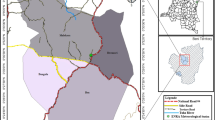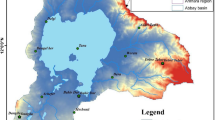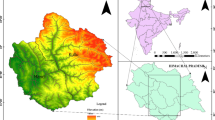Abstract
The implications of climate change on water resources are of major concerns worldwide. Arid regions of the world need proper management for the water resources as climatic changes are bringing severe problems for their sustainability. Pothohar area of Pakistan is the most essential in this regard. A data set of 30 years of temperature, precipitation, and river discharge across the Pothohar Plateau were obtained from Pakistan Meteorological Department and Water and Power Development Authority, respectively. Hydro-meteorological data were subjected to a series of statistical methods for detecting trend and abrupt point changes. A rising trend in mean annual temperatures were noticed in all stations with most significant change in Jhelum and Attock stations (p < 0.05) during the period of 30 years while precipitation trends were found irregular, representing both scenarios of flash floods and droughts with non-significant change (p > 0.05). In addition, 2000 and 2001 are drought years in 30 years of time series, and the driest years were seen from 1999 to 2002. The discharge of River Haro and Soan were found downward significantly (p > 0.05), posing a threatening challenge to the future of water resources in this area. The correlation coefficient test revealed a substantial relationship between mean annual precipitation and river discharge, although the linear regression model demonstrated a diminishing trend with mean annual precipitation. Based on the analysis, it is concluded that modern techniques of irrigation and agriculture should be adopted to protect the future of the Pothohar area from climate change related extreme situations.






Similar content being viewed by others
Data availability
The data sets of this study are available from Pakistan Metrological Department (PMD) and Irrigation Department of Water and Power Development Authority (WAPDA). Without permission to the concerned departments, restrictions are imposed publically to the availability of these data files. However, data are available from authors upon reasonable request and with permission of PMD and WAPDA.
References
Ahsan M, Shakir A, Zafar S, Nabi G, Ahsan E (2016) Assessment of climate change and variability in temperature, precipitation and flows in Upper Indus Basin. Int J Sci Eng Res 7:1610–1620
Ali NA, Ishfaq CAG, Raza MA (2015) Trend analysis of precipitation data in Pakistan. Sci Int 27:803–808
Archer DR, Forsythe N, Fowler HJ, Shah SM (2010) Sustainability of water resources management in the Indus Basin under changing climatic and socio economic conditions. Hydrol Earth Syst Sci 14(8):1669–1680
Bakhsh HA, Shakir AS, Khan NM (2011) Flood inundation modeling for Malir watershed of Karachi considering future mean sea level rise. Pak J Eng Appl Sci 9:34–47
Bhutiyani M, Kale VS, Pawar N (2007) Long-term trends in maximum, minimum and mean annual air temperatures across the Northwestern Himalaya during the twentieth century. Clim Change 85(1–2):159–177
Böhner J, Lucarini V (2017) Prevailing climatic trends and runoff response from Hindukush–Karakoram–Himalaya, upper Indus Basin. Earth Syst Dyn 8:337–355
Briscoe J, Qamar U, Contijoch M, Amir P, Blackmore D (2006) Pakistan’s water economy: running dry. Oxford University Press, Karachi
Cheema AR (2014) Climate change: Pakistan must invest in adaptation. Nature 514(7522):305
Chen X, Tung K-K (2014) Varying planetary heat sink led to global-warming slowdown and acceleration. Science 345(6199):897–903
Chu J, Xia J, Xu C-Y, Singh V (2010) Statistical downscaling of daily mean temperature, pan evaporation and precipitation for climate change scenarios in Haihe River, China. Theor Appl Climatol 99(1–2):149–161
Dawood M (2017) Spatio-statistical analysis of temperature fluctuation using Mann–Kendall and Sen’s slope approach. Clim Dyn 48(3–4):783–797
del Río S, Anjum Iqbal M, Cano-Ortiz A, Herrero L, Hassan A, Penas A (2013) Recent mean temperature trends in Pakistan and links with teleconnection patterns. Int J Climatol 33(2):277–290
Eriksson M, Xu J, Shrestha AB, Vaidya RA, Santosh N, Sandström K (2009) The changing Himalayas: impact of climate change on water resources and livelihoods in the greater Himalayas. International Centre for Integrated Mountain Development (ICIMOD), Lalitpur
Gedefaw M, Wang H, Yan D, Song X, Yan D, Dong G, Wang J, Girma A, Ali B, Batsuren D (2018) Trend analysis of climatic and hydrological variables in the Awash River Basin, Ethiopia. Water 10(11):1554
Ghauri B, Khan MR (2013) Short term drought monitoring using remote sensing technique: a case study of Potohar region, Pakistan. In: Paper presented at the 2013 international conference on aerospace science and engineering (ICASE)
Gilbert RO (1987) Statistical methods for environmental pollution monitoring. Wiley, New York
Gocic M, Trajkovic S (2013) Analysis of changes in meteorological variables using Mann–Kendall and Sen’s slope estimator statistical tests in Serbia. Glob Planet Change 100:172–182
Gu G, Adler RF, Huffman GJ (2016) Long-term changes/trends in surface temperature and precipitation during the satellite era (1979–2012). Clim Dyn 46(3–4):1091–1105
Hagemann S, Chen C, Clark DB, Folwell S, Gosling SN, Haddeland I, Hanasaki N, Heinke J, Ludwig F, Voss F (2013) Climate change impact on available water resources obtained using multiple global climate and hydrology models. Earth Syst Dyn 4(1):129–144
Helsel DR, Hirsch RM (1992) Statistical methods in water resources, vol 49. Elsevier, Amsterdam
Jianyun Z, Guoqing W, Yang Y, Ruimin H, Jiufu L (2009) Impact of climate change on water security in China. 气候变化研究进展 5(00):34–40
Kahya E, Kalaycı S (2004) Trend analysis of streamflow in Turkey. J Hydrol 289(1–4):128–144
Kazmi DH, Rasul G (2012) Agrometeorological wheat yield prediction in rainfed Potohar region of Pakistan. Agric Sci 3(02):170
Kazmi DH, Li J, Ruan C, Zhao S, Li Y (2016) A statistical downscaling model for summer rainfall over Pakistan. Clim Dyn 47(7–8):2653–2666
Khan NA (2011) Analysis of flood causes and associated socio-economic damages in the Hindukush region. Nat Hazards 59(3):1239
Khan AJ, Ali Z, Ahmad I, Ahmad MN (2016) The challenge of climate change and policy response in Pakistan. Environ Earth Sci 75(5):412
Latif Y, Yaoming M, Yaseen M (2018) Spatial analysis of precipitation time series over the Upper Indus Basin. Theor Appl Climatol 131(1–2):761–775
Liemberger R, Marin P (2006) The challenge of reducing non-revenue water in developing countries--how the private sector can help: A look at performance-based service contracting. Water supply and sanitation sector board discussion paper series 39405, paper No. 8. The International Bank for Reconstruction and Development/The World Bank,Washington, DC
Mahmood R, Jia S (2017) Spatial and temporal hydro-climatic trends in the transboundary Jhelum River basin. J Water Clim Change 8(3):423–440
Mahmood R, Jia S, Babel M (2016) Potential impacts of climate change on water resources in the Kunhar River Basin, Pakistan. Water 8(1):23
Malik W, Shahid H, Zafar R, Uddin Z, Wazir Z, Anwar Z, Khattak JZK, Ali SS (2012) Role of Pakistan in global climate change through greenhouse gas emissions (GHGs). Res J Environ Earth Sci 4(11):996–1001
Mavromatis T, Stathis D (2011) Response of the water balance in Greece to temperature and precipitation trends. Theor Appl Climatol 104(1–2):13–24
Mitchell J, Dzerdzeevskii B, Flohn H, Hofmeyr W, Lamb H, Rao K,Wallén C (1966) Climatic change. Technical Note, No. 79. World Meteorological Organization, Geneva, Switzerland, p 99
Mujumdar P, Ghosh S (2008) Climate change impact on hydrology and water resources. ISH J Hydraul Eng 14(3):1–17
Nachar N (2008) The Mann–Whitney U: a test for assessing whether two independent samples come from the same distribution. Tutor Quant Methods Psychol 4(1):13–20
Partal T (2010) Wavelet transform-based analysis of periodicities and trends of Sakarya basin (Turkey) streamflow data. River Res Appl 26(6):695–711
Pettitt AN (1979) A non-parametric approach to the change-point problem. J R Stat Soc Ser C (appl Stat) 28(2):126–135
Ramadan H, Beighley R, Ramamurthy A (2012) Temperature and precipitation trends in Lebanon’s largest river: The Litani Basin. J Water Resour Plan Manag 139(1):86–95
Rashid K, Rasul G (2011) Rainfall variability and maize production over the Potohar Plateau of Pakistan. Pakistan Journal of Meteorology 8(15):63–74
Rasul G, Chaudhry Q, Mahmood A, Hyder K, Dahe Q (2011) Glaciers and glacial lakes under changing climate in Pakistan. Pak J Meteorol 8(15):1–8
Salma S, Rehman S, Shah M (2012) Rainfall trends in different climate zones of Pakistan. Pak J Meteorol 9(17):37–47
Salmi T, Määttä A, Anttila P, Ruoho-Airola T, Amnell T (2002) Detecting trends of annual values of atmospheric pollutants by the Mann-Kendall test and Sen’s slope estimates MAKESENS–The excel template application. Finish Meteorological Institute, Helsinki
Sanaullah M, Ahmad I, Arslan M, Ahmad SR, Zeeshan M (2018) Evaluating Morphometric Parameters of Haro River Drainage Basin in Northern Pakistan. Pol J Environ Stud 27(1):459–465
Sen PK (1968) Estimates of the regression coefficient based on Kendall’s tau. J Am Stat Assoc 63(324):1379–1389
Shaheen A, Baig MA (2011) Drought severity assessment in arid area of Thal Doab using remote sensing and GIS. Int J Water Resour Arid Environ 1(2):92–101
Shahid M, Cong Z, Zhang D (2018) Understanding the impacts of climate change and human activities on streamflow: a case study of the Soan River basin, Pakistan. Theor Appl Climatol 134(1–2):205–219
Shakoor U, Saboor A, Ali I, Mohsin A (2011) Impact of climate change on agriculture: empirical evidence from arid region. Pak J Agric Sci 48(4):327–333
Shaw R (2015) Floods in the Hindu Kush Region: causes and socio-economic aspects. In: Mountain hazards and disaster risk reduction. Springer, pp 33–52
Some’e BS, Ezani A, Tabari H (2012) Spatiotemporal trends and change point of precipitation in Iran. Atmos Res 113:1–12
Stocker TF, Qin D, Plattner G-K, Tignor M, Allen SK, Boschung J, Nauels A, Xia Y, Bex V, Midgley P (2013) Climate change 2013: the physical science basis. Cambridge University Press, Cambridge
Tahir AA, Chevallier P, Arnaud Y, Neppel L, Ahmad B (2011) Modeling snowmelt-runoff under climate scenarios in the Hunza River basin, Karakoram Range, Northern Pakistan. J Hydrol 409(1–2):104–117
Tahir AA, Adamowski JF, Chevallier P, Haq AU, Terzago S (2016) Comparative assessment of spatiotemporal snow cover changes and hydrological behavior of the Gilgit, Astore and Hunza River basins (Hindukush–Karakoram–Himalaya region, Pakistan). Meteorol Atmos Phys 128(6):793–811
Tariq A, Riaz I, Ahmad Z, Yang B, Amin M, Kausar R, Andleeb S, Farooqi MA, Rafiq M (2020) Land surface temperature relation with normalized satellite indices for the estimation of spatio-temporal trends in temperature among various land use land cover classes of an arid Potohar region using Landsat data. Environ Earth Sci 79(1):40
Trenberth KE (2011) Changes in precipitation with climate change. Clim Res 47(1–2):123–138
Uddin M, Akter S, Uddin M, Diganta M (2017) Trend analysis variations and relation between discharge and rainfall: a study on Kushiyara River. J Environ Sci Nat Resour 10(2):121–132
Ullah A, Sun H, Yang X, Zhang X (2017) Drought coping strategies in cotton: increased crop per drop. Plant Biotechnol J 15(3):271–284
Volodin E, Yurova AY (2013) Summer temperature standard deviation, skewness and strong positive temperature anomalies in the present day climate and under global warming conditions. Clim Dyn 40(5–6):1387–1398
Wang H, Li Q, Gao Z, Sun B, Du X (2014) Assessment of land degradation using time series trends analysis of vegetation indictors in Beijing–Tianjin dust and sandstorm source region. In: Paper presented at the 2014 IEEE geoscience and remote sensing symposium
Winston HY, Yang Y-C, Savitsky A, Alford D, Brown C (2013) The Indus basin of Pakistan: the impacts of climate risks on water and agriculture. World Bank Publication, Geneva
Yang Z, Shahid M, Wei N, Huang Y, Waqas M,Tu S (2019) Water preservation in Soan River Basin using deep learning techniques. arXiv preprint arXiv:1906.10852
Yue S, Wang C (2004) The Mann–Kendall test modified by effective sample size to detect trend in serially correlated hydrological series. Water Resour Manag 18(3):201–218
Zabaleta A, Meaurio M, Ruiz E, Antigüedad I (2014) Simulation climate change impact on runoff and sediment yield in a small watershed in the Basque Country, northern Spain. J Environ Qual 43(1):235–245
Zhang Q, Gu X, Singh VP, Kong D, Chen X (2015) Spatiotemporal behavior of floods and droughts and their impacts on agriculture in China. Glob Planet Change 131:63–72
Acknowledgements
We are thankful to the Pakistan Meteorological Department (PMD) and Irrigation Department of Water and Power Development Authority (WAPDA) for the acquisition of the hydro-meteorological data and entire support during the study.
Author information
Authors and Affiliations
Corresponding author
Additional information
Responsible Editor: Clemens Simmer, Ph.D.
Publisher's Note
Springer Nature remains neutral with regard to jurisdictional claims in published maps and institutional affiliations.
Rights and permissions
Springer Nature or its licensor (e.g. a society or other partner) holds exclusive rights to this article under a publishing agreement with the author(s) or other rightsholder(s); author self-archiving of the accepted manuscript version of this article is solely governed by the terms of such publishing agreement and applicable law.
About this article
Cite this article
Khalid, S., Naz, A., Rahman, Z.u. et al. Trend analysis of hydro-meteorological variables of Islamabad, Pakistan: a spatio-temporal view from Pothohar region. Meteorol Atmos Phys 135, 30 (2023). https://doi.org/10.1007/s00703-023-00970-5
Received:
Accepted:
Published:
DOI: https://doi.org/10.1007/s00703-023-00970-5




